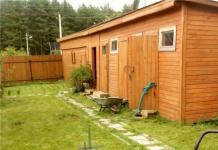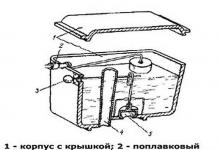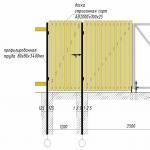Many owners postpone the construction of frame houses in winter and in vain. It is worth looking around and it becomes clear that in the cold, the pace of development does not decrease at all, so the question: is it possible to build a house in winter using frame technology, there is only one answer - it is possible. During the frost period, the construction of buildings has a lot of advantages and some disadvantages. Suppose, starting work in the first winter months, in the spring you will already move into your own house, start working on the site - this is perhaps one of the main advantages.
Turnkey construction in winter: features of the work
Even the most frosty weather has a plus - no precipitation. No moisture, which means that the lumber will retain all its qualities and they will only have to be covered so that the snow does not spoil it.
The second plus - buildings give less shrinkage. Despite the fact that frame houses do not shrink at all, however, there may be changes, especially if some technological subtleties were not observed in full.
Important! Starting the construction of a frame house in winter, you need to take care of either the availability of material on the construction site or good access roads. And, by the way, even if it is difficult to drive out of the city in the summer, then the winter trails do not have any obstacles for the transport of building materials.
Another advantage is the price. In winter, the cost of materials is significantly reduced, which means that savings on all types of work increase.
When working with insulation, OSB boards, temperature does not matter. An obstacle may be the use of some roofing materials that cannot be laid in frost. Work on the arrangement of the foundation is permissible up to a drop mark of -25 degrees, but only with the use of certain brands of cement.
The winter period is not at all a reason to postpone the construction of a house, but it is worthwhile to deal with the minuses.
Flaws:
- Too severe frosts will not allow physical work at the facility;
- Blizzards, especially protracted ones, will also increase the construction period;
- There are extremely rare cases of house shrinkage in case of violation of technology, then it will be possible to replace some element only after thawing the soil.
To prove once again that it is possible to build a house in winter, take into account the following factors: low fire risk, minimum rainfall (735 mm in summer, only 200 mm in winter), the ability to save on materials and hiring a team of builders - prices always fall during cold periods.
winter foundation

This is the main reason that the owner is postponing construction. But you can prepare the foundation in the summer or, as already mentioned, work with concrete up to certain temperatures. Today, manufacturers offer a lot of compounds that can heat the hardening mass for a more even pour - such expenses will not raise the cost of the project by much, but there will be no problems with the supporting base.
In addition, you can choose a foundation on screw piles, an ideal option for frame construction and you can work even in severe cold - pile elements are screwed into the ground below the freezing point. A preliminary analysis of the soil will tell you the level of penetration, and everything else is completely in the hands of the owner.
Winter work rules

As a matter of fact, these rules are also good in summer, but in winter their observance is a guarantee of the accuracy of the work and the construction of a really good strong house:
- Racks, strapping, braces from a beam of cross-section 50 * 100 or 100 * 100 mm are used.
- The step of the bars is 50-150 cm.
- The base for the frame is the lower harness, laid out on the foundation, previously protected by a waterproofing material, for example, sheets of roofing material.
- The harness can be made from logs, boards, timber. Either the basement beams or the top of the foundation will serve as a support.
- The frame is connected by means of nails, screws, staples, spikes.
- The distance between the uprights is calculated by the stiffness conditions, but it is better to mount it taking into account the size of the insulation sheet.
- The design scheme should clearly distribute the loads, transferring them along the bearing elements, therefore the step between the frame racks should be no less and no more than the inter-beam step of the attic and basement.
- Plank struts are mounted for frame rigidity.
- Support for window frames and doorways - bars, additionally cut into the structure.
- The top-type harness is attached to the racks by means of spikes, then the ceiling beam elements are cut into it, on which the rafters are then mounted.
- Partitions in the house can be based on interlag beams, on the floor or a board laid on the floor.
- External cladding is made with any available material: planed boards, OSB boards, plywood. A wind protection is necessarily attached to the material, which will block the blowing of the house and ensure the removal of water vapor from the walls.
Important! If a "wet facade" cladding is planned, a windproof membrane is not required.
- Insulation is laid inside the frame. Mineral wool, polyurethane foam, glass wool cloth acts as a heater. The insulation must be waterproofed and sewn up with an inner lining.

It is possible to build a frame house in winter, especially if the foundation is already ready and all materials have been delivered. As a rule, the work is not delayed. It is enough to give 3-4 weeks to all the work and the building will be ready. With a ready foundation, deviations from the project are not expected, it is only important to choose the right team or enlist your own patience and experience. Of course, if you build a house alone, it will take more time, but the price of the project will decrease. So, the answer to the question: is it possible to build a frame house in winter, received. Take care of the following points:
- Access roads to the construction site;
- Finished foundation. So that the work does not take time, and by the time the house was erected, the foundation was well tested by frozen soil;
- Organize space for construction. Here you have to lay something on the ground, otherwise the snow will melt and all the materials will be dirty. A geogrid, which is laid in parking lots, will come in handy; after completion of work, it is easy to use it for its intended purpose;
- Protect the material from snow both from the ground and from above (a large piece of film is enough);
- Correct calculation of the amount of work per daylight hours.
There are no difficulties in building a frame house in the cold. There is no need to work with materials that freeze in the cold and therefore become brittle. Ondulin, roofing material and other materials will fit perfectly for the roof. Even if the roof is temporary, in the spring you can cover the house with something durable - if you have a prepared box, the work will be quick.
You won’t surprise anyone with a foundation wrapped in polyethylene and winter change houses for a long time. Autumn construction in central Russia has become commonplace. And this is understandable: from September-October, discounts on building materials begin, foremen become more accommodating in matters of payment, and the flow of cars decreases on large “outbound” highways. It is believed that autumn construction saves up to 20-25 percent of the budget. And construction companies assure that modern techniques make it possible not to interrupt work either in rain, or in snow, or in frost. Partly so it also is. Nevertheless, many experts advise not to rely too much on technology and take into account the peculiarities of both the national climate and mentality.
Preparatory work If you think that a house starts with a foundation, you are seriously mistaken. The house begins with the selection and purchase of a site, the study of its features, design work. This first stage of your construction can be carried out at any time of the year. And autumn is probably the best.
Our opinion: - A lot of building exhibitions take place in autumn, where you can learn a lot of interesting things about modern building technologies, materials, types of houses, etc. It is also worth taking a closer look at the designers and contractors. In autumn, geological work and geodetic surveys can be carried out. Both types of work should not be underestimated - they are key to choosing the type and design of the foundation. Finally, at this time, you can calmly and without haste discuss with the architect, designer and constructor all the nuances of your future home.
Mikhail Egiyan, architect: - First you need to think about what kind of house you want to build, then order a project, then transfer it to the designer, who will make the necessary calculations, taking into account the characteristics of your site and the type of building. If you want a good, solid foundation, you can't skimp on any of these stages. Do not think that if a neighbor has sand, then you have it too. You need to trust the work of a professional. torard.ru
Below zero The zero cycle of construction begins with providing a convenient access for equipment, unloading materials, creating a site where you will store them. Do not forget about protection from rain and wind, given the capricious nature of the "golden time". It’s also a good idea to take care of acceptable working conditions for workers - albeit a small, but insulated and heated room in case of unexpected frosts and cold weather. In addition, autumn is the time of a rapid reduction in daylight hours, which means that you will have to think over the lighting of the object, again well protected from bad weather.
Our opinion: - Whatever foundation you would prefer, you will have to drain, dig and compact the soil under it. Autumn is not the best time to carry out these works, especially during the rainy season. Therefore, they usually try to finish them by the end of summer or at least the very beginning of autumn. On the question of whether it is worth laying the foundation in the fall, even the builders have no consensus. On the one hand, manufacturers of building materials claim that modern construction methods make it possible to build structures at any time of the year - look at monolithic houses growing like pies, for example. On the other hand, “winter” construction technologies, at the slightest miscalculation, multiply all the benefits by “zero” and significantly increase costs.
For example, theoretically "winter" concrete with antifreeze additives allows you to work at significant negative temperatures. But with strong drops - and this often happens with us in the fall - it can behave unpredictably. "Heating" the foundation with heat guns is both a costly exercise and not always reliable in practice. In rainy weather, mixtures with additives that increase moisture resistance are used, but even they are not recommended to be poured during heavy rains.
Mikhail Egiyan, architect: - If the foundation needs to be deeply buried, it needs good waterproofing. In order for the concrete to dry and harden properly, it needs one and a half to two months. It is desirable that they fall on a relatively dry time of the season. Here also consider. We usually try to finish the foundation work before November. That is, it is best to start no later than the first days of September. torard.ru
In Soviet times, it was believed that a house, the foundation of which was laid in the fall, but before the start of the rainy season, would be the most reliable. After winter frosts and snow melting, it will be seen how well the work was carried out, many mistakes can be corrected, and the foundation itself will properly “settle”.
Our opinion: But this approach also has its downsides. First, the construction time is being extended. Secondly, if there is too much water in the spring, then a shallow strip foundation, for example, may be too saturated with water and even deform. To avoid this, in the fall, before the conservation of construction, they dig a drainage trench. The so-called screwed piles are considered an "all-weather" version of the foundation. But these are only suitable for very light structures - garages or bathhouses, for example, and often "float" in the spring along with the house, if they were installed illiterately in the fall.
Mounting in rain and snow You can assemble a house from "factory" sandwich panels or profiled timber at any time of the year. And yet, during heavy rains, even these works can be difficult to carry out. For advice, we turned to the architect Alexander Borisov, whose company in just a few months is building modern frame houses according to individual projects of another well-known Moscow architect - Ivan Shalmin.
Alexander Borisov, architect: - The main thing is to finish all the work with the soil before the rains. The frame house can also be assembled in wet weather. The timber itself is pre-treated with antiseptics and dried properly. After that, the humidity is not afraid of him. And the assembly process can be organized by pulling awnings over the entire site. But even here there may be nuances. It is good if the site where the work is being carried out is located in a pine forest. Then - no problem. What if it's a windswept open area? With a very strong wind with rain, it is difficult and unsafe to assemble a house even under an awning. But there are no temperature restrictions for our construction technology. As soon as the autumn rains and winds pass, construction can be resumed in full. Installation of a frame house with an area of about 150 meters will take about 4-5 months. borisovpro.com
Excess moisture and low temperatures are contraindicated for brick houses and block houses. Winter construction technologies and special mortar additives exist here as well. But the risks are very high. During sub-zero night temperatures, water freezes in microcracks and pores. Given the high cost of brick housing, mistakes can result in very serious amounts, and therefore winter construction using this technology is more an exception than a rule. Such buildings are most often preserved until spring. But for wooden structures, winter, on the contrary, is a good time.
Typically, the construction season begins in late spring or early summer. This is the time when the roads have already dried up, which facilitates quick transportation. Daylight hours are longer and the weather is warmer. However, the construction of frame houses in winter is very appropriate. There are many reasons for this, for example:
- it is well known that it is best to build from wood harvested in the winter season. After all, it is in winter that the wood is denser and drier, since the sap in the trees stops moving. As a result, such wood is less prone to cracking and deformation.
- in frost, the appearance of mold on wood is almost impossible. After all, heat, moisture and oxygen are vital for the reproduction of the fungus.
- in the manufacture of the moisture content of glued laminated timber is 10-12%. In damp weather on a construction site, it picks up moisture from the air. And in the cold, the moisture from the wood gradually freezes out, therefore, when building frame houses in winter, you will get a structure that gives a more uniform and less draft than in spring or autumn.
- it is best to bring building materials to the site when there is no dirt and dust on the road.
- for the construction of houses of other types, the construction season begins closer to summer, respectively, both demand and prices for building materials are growing.
A frame wooden house, even the largest, does not weigh that much. Therefore, for its construction, a shallow depth of strip foundation is used. If you let him stand a little, then he will not swell.
The foundation is laid at the end of autumn, and we begin the construction of frame houses in winter - a great time to build a structure!
Now you know whether it is possible to build a frame house in winter. After all, the remaining stages of construction are not particularly different, given some circumstances. Since daylight hours are shorter in winter, it is necessary to take care of artificial lighting. Working with a tree in frost requires the presence of qualified carpenters. Air temperatures below minus 25°C are very rare, so workers usually do not stop construction for a long time. But it is better to finish the house when it gets warmer, let it stand for a while. Building frame houses in winter means you can move into your new home as early as the middle of summer.
A wooden house will easily captivate you with its unique nobility, as well as a real natural smell. Modern projects of wooden houses are able to win the heart of any, even the most demanding client. Intel Group will help you build your own country house or cottage and create family comfort in it!
Building a house is a real event that happens only once in a lifetime for many. Of course, in this case, it is necessary to provide for all possible adverse factors in order to avoid errors. If you are going to build in the fall, then there are some nuances here, which we will consider below.
Material
Let's say you've done a site survey, obtained permits at a cost of time and money, and come directly to the construction phase. It is important to understand here that moisture, dampness and the approaching winter are your main enemies.
Also, a lot depends on the material from which you are going to build:
- - reliable, warm and durable material, however, it needs mandatory winter protection. In addition, brick construction is a long process, and if you decide to build in the fall, you will have to rush the team to complete the box and floors before the winter cold. The foundation is tape, and even a basement is better.

- - a convenient material, which, due to the large size of the building blocks, allows you to quickly build a full-fledged two-story mansion. The foundation (of course, the terrain factor also plays a role here) is tape, or basement.

- - rounded logs, hewn or glued beams, are just perfect for autumn construction. But only if the forest was not harvested in spring or summer, since the processes of sap flow in it have not yet ended.
For autumn construction, a dry “winter” forest is suitable, that is, harvested the previous winter. In the fall, they make a foundation, a box and a roof, in the winter they let it settle (ideally, in the spring too), so that shrinkage and the so-called “swelling” of the wood occur, but in the summer you can start finishing. It is important to understand that a wooden house needs time to “settle” and shrink, moreover, the roof should be done immediately after the box is ready. Otherwise, after the construction of the roof, it will be necessary to wait again for six months, since the load on the walls will again create shrinkage. The foundation is better than a tape one, but a pile foundation is also possible.

- (on screw piles or strip foundation) - perhaps the most convenient option for construction in the fall. Such a house can be built entirely in autumn, even if the project involves two floors with an attic. Well, in winter, you can easily start interior decoration, and the house itself practically does not shrink.
So, if you want to completely build up for the autumn season and get a warm, cozy and durable house without stretching the construction process, choose a frame-panel house. Yes, and modern construction technologies make it possible to create a frame-panel house, which, in terms of heat saving and structural reliability, will not only not yield, but also surpass brick.

Foundation and "preservation" for the winter
Regardless of which option you choose, there is one very important point - this is the foundation. For each of the construction materials described above, we have proposed an appropriate foundation option, however, this is not an immutable rule.

Often the terrain dictates its own conditions, and, for example, it is impossible, or very difficult, to make a basement foundation. Then you can build a brick house with a strip foundation without a basement. A two-story wooden mansion may well be built on one of the pile foundations. The main thing is that the reconnaissance of the site is carried out by a competent architect who will help you figure out what's what and choose the best option, taking into account all the subtleties.

Whatever house or foundation you choose, in the fall it is quite possible to bookmark it. It is also necessary to take into account the weather conditions - if the builders managed to drive out the load-bearing walls and roof slabs, and at that moment frosts came, many postpone further construction until spring. In this case, it is necessary to cover the floors from frost and snow with roofing material, or a film, and even better - combine them with foam.
Window and door openings (garage - including) need to be hammered with boards and then you don’t have to worry about the arrival of winter. Well, in the spring, when the snow melts, you can continue work - make a roof (if you didn’t have time to do it before the cold weather), and start finishing work outside and inside, carry out heating and dig holes for a septic tank.
Another opportunity to quickly and inexpensively build a house in the fall is to order a prefabricated frame cottage. However, summing up, we recommend not to rush things unnecessarily. Well, if you really need to build in one season - do not allow amateur performances, because the house is being built for years, and the process must be approached with all responsibility, choosing only professionals.

The material was prepared with the information support of the company's specialists in the design and construction of houses ""
Just a few months is impossible. Unforeseen difficulties often arise that can stall the process for a long time. Even if the construction of the cottage began in the spring, it is hardly possible to have time to complete everything by the winter cold. Well, if you are already planning the construction of a house in the fall, then even more so you need to adhere to special rules for carrying out work in order to avoid many troubles in the future.
The feature of the soil on which your site is located plays a big role. In cold weather, wet soil can expand and push out the foundation of the house, especially if it was laid shallow.
Therefore, if housing is located in a wetland, in the spring, its owners may encounter certain troubles (for example, a cracked structure). To a greater extent, this applies to a reinforced concrete monolithic foundation.
 Cracks that occur in a monolithic reinforced concrete foundation
Cracks that occur in a monolithic reinforced concrete foundation Precautions during construction in autumn
If your goal is to lay the foundation during the autumn cold, before starting work, you should take into account some safety measures.
A set of measures to protect the foundation from frost and dampness:
- It is necessary to add protective components to the composition of concrete, which can maintain the optimal temperature regime for high-quality drying.
- Installation of special formwork.
- Heating with cable and infrared lamps.
Advantages of winter construction
- In winter, the demand for materials decreases significantly, which allows significant savings.
- In winter it will be much easier to get to the cottage, as there are almost no traffic jams.
Cons of winter construction
- If, then a heated change house for builders will definitely be required. It is advisable to fold a small one in the summer, but rather than use a weak “potbelly stove” for heating. In addition, it is necessary to purchase a supply of firewood or another type of fuel for the stove.
 Wooden change house for builders
Wooden change house for builders - If there is one on the site, then you will need to take care of the reliability of the electrical wiring and heating elements.
- Naturally, people need to eat something, so you need to equip a gas stove and several gas cylinders.
- There may be problems with the foundation. Ideally, it is recommended to equip the foundation in the fall, when the “dacha” season has already ended, and the frosts have not yet hit. - it is difficult, but fast, especially if it is possible to fill it with ready-made factory concrete. As practice shows, it is fast, and it comes out much cheaper.
How to fill the foundation in the fall
The foundation is, perhaps, the main basis for building a house. Many people believe that pouring the foundation is only necessary in dry weather. Experts also differ in this opinion, but, despite the difference in opinions, it is still possible to pour the foundation in the fall if heavy rains do not interfere with this matter.

Is it possible to pour the foundation in rainy weather
Builders argue that wet and humid weather is best suited for pouring the foundation, as this contributes to the quality of concrete solidification. In addition, several methods and materials can be used, thanks to which work can be carried out throughout the year (except for days when it rains heavily and is cold). One such method is the use of certain grades of cement mixture, which can increase the moisture resistance of concrete.
These brands of cement include: M-600, M-500, M-450 and M-400. This mixture is often used for the construction of dams, bridge abutments and similar structures, which are often exposed to strong water during use.
- After pouring the foundation in wet and humid weather, it must be covered with plastic wrap to avoid erosion.
- During the construction process, when choosing a suitable brand of concrete, it is advisable to seek help from specialists who will help you choose the best option.
Many people believe that it is better to pour the foundation during the construction of an individual house in the fall, due to which its foundation will give a more reliable and natural draft, so that cracks can be avoided in the future.

A high-quality foundation is the main condition for the long operation of a building. In this case, it is necessary to take into account not only the brand of concrete, but also the method of pouring the foundation itself. If the depth and height are too large, it is recommended to pour continuously, using a building vibrator. This will avoid voids in the base, thereby contributing to the formation of a better monolithic mass. With the observance of the necessary technologies, it is possible to achieve a high-quality result and a long service life of the building.


















